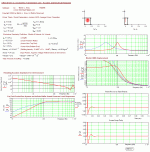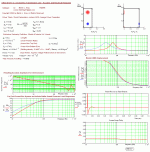Thanks to bjorno for running the simulations. Having this information is a start. For now, we can assume that the simulation has some degree of validity to actual performance if such a system were built. While I have not built any of these particular systems, the closed box simulation results are very close to other four-inch advertised diameter transducers I have tested in regard to the variable of x-max and spl. I have not been able to verify accuracy for the vented designs using other transducers.
What, however, dear readers of the thread, do you believe the results mean for the original question? On the surface, the simulation results disagree with what the "ears" have reported as personal testimonies.
How might we explain this? What might this say for the validity of "design" numbers for music reproduction? After all, what is the lowest fundamental frequency of the instruments used in the music we listen to. For the acoustic bass, an open e string is tuned to 48 Hz (if my memory is correct). How often is the open e plucked? Anyone have an position on this?
I also believe that the simulator predictions ought to be tested for the vented designs. Is anyone going to be able to do this and report on the results?
What, however, dear readers of the thread, do you believe the results mean for the original question? On the surface, the simulation results disagree with what the "ears" have reported as personal testimonies.
How might we explain this? What might this say for the validity of "design" numbers for music reproduction? After all, what is the lowest fundamental frequency of the instruments used in the music we listen to. For the acoustic bass, an open e string is tuned to 48 Hz (if my memory is correct). How often is the open e plucked? Anyone have an position on this?
I also believe that the simulator predictions ought to be tested for the vented designs. Is anyone going to be able to do this and report on the results?
MarkMcK said:After all, what is the lowest fundamental frequency of the instruments used in the music we listen to. For the acoustic bass, an open e string is tuned to 48 Hz (if my memory is correct). How often is the open e plucked? Anyone have an position on this?
I also believe that the simulator predictions ought to be tested for the vented designs. Is anyone going to be able to do this and report on the results?
I have so far built 4 cabinet designs for the JX92S. Am on my way out to the garage to build a pair for for a 9 litre vented enclosure, oviod in form.
My room is nominally 15' x 12' x 9'. All the cabinets produce enough bass for my needs (including e.g. Bach Toccata and fugue in D Minor). Room gain helps considerably. Fast pedal runs are not always as clean as one would hope; is this the driver, the design, or the wooden floor and cellar below.
It is particularly important to feed enough bass into the driver. A powerful amp. with good power supply does wonders.
Baffle step correction is obligatory.
My position on reproducing bass is: if it isn't there something fundamental is missing (pun intended). If you listen in a concert hall you can hear undistorted bass, and it is wonderful. At home you must just judge how much money to spend.
Hope this helps,
Andy
Forgot to mention: watching cone displacement in these resonant enclosures is amusing, and slightly scary. Cone hardly moves until the port stops resonating, then it flaps in and out more than you imagine it could. Frequencies are now very low, you can almost see it in the cone movement, and all your brain needs is a fairly strong suggestion that the note is present. If you can get enough to make your chest vibrate, that is a bonus.
If the distortion is even order, then of course it almost makes things better
Andy
If the distortion is even order, then of course it almost makes things better
Andy
Having achieved the perfect bass system you often find in the UK that your room just is not the right length/shape to produce the bass. The average lounge size in the UK appears to be about 17' X 11.5 ' , which severely limits the lowest freqeuncy and gives rise to dreadful width resonances. It also means you are forced to sit a the worst location - next to the side wall.
My last house had a great room of 17' X 20' with open staircase - the only problem was carpeting it. Guess what - carpet seems to come in 12' width!
My last house had a great room of 17' X 20' with open staircase - the only problem was carpeting it. Guess what - carpet seems to come in 12' width!
Lot's of people fail to identify what kind of bass performance they are looking for, punch or resonance. For enough punch like a real cannon, you need the driver air pushing volume capability, if you are looking for the resonant type low frequency take less travel to sound satifactory. If you look at human ear sensitivity, you will find that the low frency curves come closer together. Additionally, If you try to move lots of air in a small room, the results would differ significantly from doing the same in a large room. So matching speaker size to room is also important.
I agree about the room to speaker matching requirement. I'm currently experimenting with a sub-woofer capable of going down to 17Hz (manufacturer's claim, not mine). In my room it is audible on a test tone at 30Hz but has all-but disappeared at 25Hz. This would seem to indicate that one of the reasons I get on so well with the larger of GM's MLTLs for the JX92 is that it rolls off below 35Hz, matching in to the room roll off quite well.
Incidentally, am I right in thinking that there would be less cone flap if a vented (or MLTL) enclosure is tuned lower, on the basis that the lower you push the vent, the less music is available below that to agitate the cone where it isn't loaded by enclosure or vent? That's a horrible sentence but I hope someone gets the idea.
Incidentally, am I right in thinking that there would be less cone flap if a vented (or MLTL) enclosure is tuned lower, on the basis that the lower you push the vent, the less music is available below that to agitate the cone where it isn't loaded by enclosure or vent? That's a horrible sentence but I hope someone gets the idea.
- Status
- This old topic is closed. If you want to reopen this topic, contact a moderator using the "Report Post" button.
- Home
- Loudspeakers
- Full Range
- Jordan JX92S power handling

